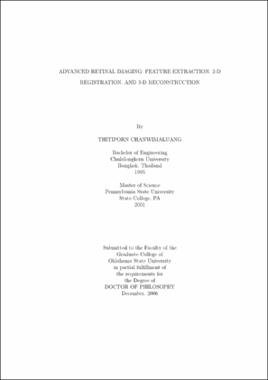| dc.contributor.advisor | Fan, Guoliang | |
| dc.contributor.author | Chanwimaluang, Thitiporn | |
| dc.date.accessioned | 2013-12-10T18:05:46Z | |
| dc.date.available | 2013-12-10T18:05:46Z | |
| dc.date.issued | 2006-12 | |
| dc.identifier.uri | https://hdl.handle.net/11244/7849 | |
| dc.description.abstract | In this dissertation, we have studied feature extraction and multiple view geometry in the context of retinal imaging. Specifically, this research involves three components, i.e., feature extraction, 2-D registration, and 3-D reconstruction. First, the problem of feature extraction is investigated. Features are significantly important in motion estimation techniques because they are the input to the algorithms. We have proposed a feature extraction algorithm for retinal images. Bifurcations/crossovers are used as features. A modified local entropy thresholding algorithm based on a new definition of co-occurrence matrix is proposed. Then, we consider 2-D retinal image registration which is the problem of the transformation of 2-D/2-D. Both linear and nonlinear models are incorporated to account for motions and distortions. A hybrid registration method has been introduced in order to take advantages of both feature-based and area-based methods have offered along with relevant decision-making criteria. Area-based binary mutual information is proposed or translation estimation. A feature-based hierarchical registration technique, which involves the affine and quadratic transformations, is developed. After that, a 3-D retinal surface reconstruction issue has been addressed. To generate a 3-D scene from 2-D images, a camera projection or transformations of 3-D/2-D techniques have been investigated. We choose an affine camera to characterize for 3-D retinal reconstruction. We introduce a constrained optimization procedure which incorporates a geometrically penalty function and lens distortion into the cost function. The procedure optimizes all of the parameters, camera's parameters, 3-D points, the physical shape of human retina, and lens distortion, simultaneously. Then, a point-based spherical fitting method is introduced. The proposed retinal imaging techniques will pave the path to a comprehensive visual 3-D retinal model for many medical applications. | |
| dc.format | application/pdf | |
| dc.language | en_US | |
| dc.rights | Copyright is held by the author who has granted the Oklahoma State University Library the non-exclusive right to share this material in its institutional repository. Contact Digital Library Services at lib-dls@okstate.edu or 405-744-9161 for the permission policy on the use, reproduction or distribution of this material. | |
| dc.title | Advanced retinal imaging: Feature extraction, 2-D registration, and 3-D reconstruction | |
| dc.contributor.committeeMember | Yen, Gary G. | |
| dc.contributor.committeeMember | Piao, Daqing | |
| dc.contributor.committeeMember | Madihally, Sundararajan V. | |
| osu.filename | Chanwimaluang_okstate_0664D_2094 | |
| osu.accesstype | Open Access | |
| dc.type.genre | Dissertation | |
| dc.type.material | Text | |
| thesis.degree.discipline | Electrical and Computer Engineering | |
| thesis.degree.grantor | Oklahoma State University | |
